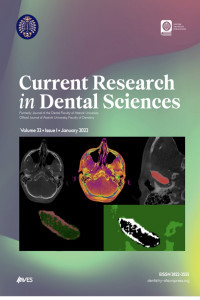EVALUATION OF EFFECT OF IMPRESSION TECHNIQUES TO SATISFACTION OF EDENTULOUS PATIENTS TREATED WITH IMPLANT-RETAINED OVERDENTURES: A PILOT STUDY
Overdenture, Precision attachment, Dental implant, Fabrication technique
___
- . Mack F, Schwahn C, Feine JS, Mundt T, Bernhardt O, John U et al. The impact of tooth loss on general health related to quality of life among elderly Pomeranians: results from the study of health in Pomerania (SHIP-O). Int J Prosthodont 2005;18:414-9.
- 2. Mericske-Stern RD, Taylor TD, Belser U. Management of the edentulous patient. Clin Oral Implants Res 2000;11:108-25.
- 3. Thomason JM, Kelly SA, Bendkowski A, Ellis JS. Two implant retained overdentures--a review of the literature supporting the McGill and York consensus statements. J Dent 2012;40:22-34.
- 4. Sivaramakrishnan G, Sridharan K. Comparison of implant supported mandibular overdentures and conventional dentures on quality of life: A systematic review and meta-analysis of randomized controlled studies. Aust Dent J 2016;61:482-8.
- 5. Naert I, Quirynen M, Theuniers G, van Steenberghe D. Prosthetic aspects of osseointegrated fixtures supporting overdentures. A 4-year report. J Prosthet Dent 1991;65:671-80.
- 6. Feine JS, Carlsson GE, Awad MA, Chehade A, Duncan WJ, Gizani S et al. The McGill Consensus Statement on Overdentures. Montreal, Quebec, Canada. May 24-25, 2002. Int J Prosthodont 2002;15:413-4.
- 7. Thomason JM, Feine J, Exley C, Moynihan P, Muller F, Naert I et al. Mandibular two implant-supported overdentures as the first choice standard of care for edentulous patients--the York Consensus Statement. Br Dent J 2009;207:185-6.
- 8. Pesqueira A, Goiato M, Gennari-Filho H, Monteiro D, Dos Santos D, Haddad M et al. The use of stress analysis methods to evaluate the biomechanics of oral rehabilitation with implants. J Oral Implantol 2014;40:217-28.
- 9. Heckmann SM, Winter W, Meyer M, Weber HP, Wichmann MG. Overdenture attachment selection and the loading of implant and denture-bearing area. Part 1: In vivo verification of stereolithographic model. Clin Oral Implants Res 2001;12:617-23.
- 10. Porter JA, Jr., Petropoulos VC, Brunski JB. Comparison of load distribution for implant overdenture attachments. Int J Oral Maxillofac Implants 2002;17:651-62.
- 11. Heckmann SM, Winter W, Meyer M, Weber HP, Wichmann MG. Overdenture attachment selection and the loading of implant and denture-bearing area. Part 2: A methodical study using five types of attachment. Clin Oral Implants Res 2001;12:640-7.
- 12. Alsabeeha NH, Payne AG, Swain MV. Attachment systems for mandibular two-implant overdentures: a review of in vitro investigations on retention and wear features. Int J Prosthodont 2009;22:429-40.
- 13. Celik G, Uludag B. Effect of the Number of Supporting Implants on Mandibular Photoelastic Models with Different Implant-Retained Overdenture Designs. J Prosthodont 2014;23:374-80.
- 14. Tokar E, Uludag B. Load Transfer Characteristics of Various Designs of Three-Implant-Retained Mandibular Overdentures. Int J Oral Maxillofac Implants 2015;30:1061-7.
- 15. Ichikawa T, Horiuchi M, Wigianto R, Matsumoto N. In vitro study of mandibular implant-retained overdentures: the influence of stud attachments on load transfer to the implant and soft tissue. Int J Prosthodont 1996;9:394-9.
- 16. Wee AG, Aquilino SA, Schneider RL. Strategies to achieve fit in implant prosthodontics: a review of the literature. Int J Prosthodont 1999;12:167-78.
- 17. Lee YJ, Heo SJ, Koak JY, Kim SK. Accuracy of different impression techniques for internal-connection implants. Int J Oral Maxillofac Implants 2009;24:823-30.
- 18. Burawi G, Houston F, Byrne D, Claffey N. A comparison of the dimensional accuracy of the splinted and unsplinted impression techniques for the Bone-Lock implant system. J Prosthet Dent 1997;77:68-75.
- 19. Humphries RM, Yaman P, Bloem TJ. The accuracy of implant master casts constructed from transfer impressions. Int J Oral Maxillofac Implants 1990;5:331-6.
- 20. Carr AB. Comparison of impression techniques for a five-implant mandibular model. Int J Oral Maxillofac Implants 1991;6:448-55.
- 21. Herbst D, Nel JC, Driessen CH, Becker PJ. Evaluation of impression accuracy for osseointegrated implant supported superstructures. J Prosthet Dent 2000;83:555-61.
- 22. Gregory-Head B, LaBarre E. Two-step pick-up impression procedure for implant-retained overdentures. J Prosthet Dent 1999;82:615-6.
- 23. De La Cruz JE, Funkenbusch PD, Ercoli C, Moss ME, Graser GN, Tallents RH. Verification jig for implant-supported prostheses: A comparison of standard impressions with verification jigs made of different materials. J Prosthet Dent 2002;88:329-36.
- 24. Ganddini MR, Schejtman N, Ercoli C, Graser GN. Prosthodontic application for implant carriers. J Prosthet Dent 2004;92:399-402.
- 25. Chee W, Jivraj S. Impression techniques for implant dentistry. Br Dent J 2006;201:429-32.
- 26. Jannesar S, Siadat H, Alikhasi M. A dual impression technique for implant overdentures. J Prosthodont 2007;16:327-9.
- 27. Uludag B, Celik G. An alternative impression technique for implant-retained overdentures. J Prosthet Dent 2006;96:377-8.
- 28. Uludag B, Ozturk O, Celik G. Alternate functional impression technique for implant-retained overdentures. J Prosthet Dent 2007;97:242-3.
- 29. Uludag B, Sahin V. A functional impression technique for an implant-supported overdenture: a clinical report. J Oral Implantol 2006;32:41-3.
- 30. Uludag B, Celik G, Sahin V, Ozturk O. Fabrication of implant-assisted restorations utilizing functional impression techniques: case reports. J Oral Implantol 2007;33:297-304.
- 31. Uludag B. An alternate pressure-free functional impression technique for implant-retained overdentures. J Oral Implantol 2010;36:205-7.
- 32. White KC, Ramus DL. Two-stage impression technique for overdentures. J Prosthet Dent 1989;61:452-7.
- 33. Hobkirk JA, Abdel-Latif HH, Howlett J, Welfare R, Moles DR. Prosthetic treatment time and satisfaction of edentulous patients treated with conventional or implant-supported complete mandibular dentures: a case-control study (part 1). Int J Prosthodont 2008;21:489-95.
- 34. Korkmaz C, Atay A. Evaluation of two different attachment system used for maxillary overdenture: two case reports. J Dent Fac Atatürk Uni 2014; 9:33-7.
- Başlangıç: 1986
- Yayıncı: Atatürk Üniversitesi
Aysun AKPINAR, Metin ÇALIŞIR, Cansın KARAKAN, Suat Serhan ALTINTEPE DOĞAN, Ziynet ÇINAR
COMPARISON OF THE POSTOPERATIVE PAIN AND DISCOMFORT AFTER DIODE LASER AND CONVENTIONAL FRENECTOMY
Hatice BALCI YÜCE, Feyza TULU, Özkan KARATAŞ, Fatma UÇAN YARKAÇ
Emre TOKAR, Serdar POLAT, Bülent ULUDAĞ
Nuran YANIKOĞLU, Hatice ÖZDEMİR, Melike Pınar YILDIRIM, Cenk Burak YILMAZ
